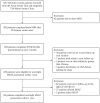Associations of sleep apnea risk and oxygen desaturation indices with cerebral small vessel disease burden in patients with stroke
- PMID: 36090876
- PMCID: PMC9452809
- DOI: 10.3389/fneur.2022.956208
Associations of sleep apnea risk and oxygen desaturation indices with cerebral small vessel disease burden in patients with stroke
Abstract
Background: Obstructive sleep apnea (OSA) is associated with cerebral small vessel disease (CSVD). Nonetheless, whether OSA-risk determined by a simple screening questionnaire or indices quantifying nocturnal hypoxemia other than the conventional apnea-hypopnea index (AHI) by the home sleep apnea test (HSAT) associated with CSVD burden remains uncertain.
Methods: From 2018 to 2021, we recruited patients with transient ischemic attack (TIA)/minor stroke from the Queen Mary Hospital Acute Stroke Unit and TIA/Stroke Outpatient Clinics. Logistic regression models were applied to determine the association of baseline OSA-risk (on STOP-BANG questionnaire) or HSAT-derived indices quantifying nocturnal hypoxemia with global burden/individual markers of CSVD on MRI. Indices included oxygen desaturation (≥3%) index (ODI), minimum oxygen saturation (SpO2), percentage of total sleep time with an oxygen saturation <90% (CT90%), and desaturation duration (≥3%, DesDur).
Results: In 283 patients with TIA/minor stroke (mean age 65 years, 64% men), OSA-risk was significantly associated with total CSVD score (multivariate-adjusted odds ratio: 1.23, 95% confidence interval 1.01-1.51), presence of lacunes [1.39 (1.09-1.79)] and burden of basal ganglia PVSs [1.32 (1.06-1.67)]. In 85/283 patients who completed HSAT, neither AHI, minimum SpO2 nor CT90% was associated with CSVD burden. Nonetheless, ODI and DesDur remained significantly associated with total CSVD score after covariate adjustment: ODI [1.04 (1.01-1.07)] and DesDur [1.04 (1.01-1.08)].
Conclusion: In patients with TIA/minor stroke, high OSA-risk was associated with a greater CSVD burden. Oxygen desaturation indices (ODI and DesDur) rather than AHI were independently associated with global CSVD burden, indicating that longer and more severe desaturations may contribute to the pathogenesis of CSVD.
Keywords: nocturnal hypoxemia; obstructive sleep apnea; oxygen desaturation; small vessel disease; stroke; transient ischemic attack.
Copyright © 2022 Liu, Lam, Mak, Ip and Lau.
Conflict of interest statement
The authors declare that the research was conducted in the absence of any commercial or financial relationships that could be construed as a potential conflict of interest.
Figures
Similar articles
-
Using a modified version of the "STOP-BANG" questionnaire and nocturnal oxygen desaturation to predict obstructive sleep apnea after stroke or TIA.Sleep Med. 2019 Apr;56:177-183. doi: 10.1016/j.sleep.2018.12.021. Epub 2019 Jan 7. Sleep Med. 2019. PMID: 30803829
-
A Modified Definition for Obstructive Sleep Apnea in Home Sleep Apnea Testing after Stroke or Transient Ischemic Attack.J Stroke Cerebrovasc Dis. 2018 Jun;27(6):1524-1532. doi: 10.1016/j.jstrokecerebrovasdis.2017.12.052. Epub 2018 Feb 7. J Stroke Cerebrovasc Dis. 2018. PMID: 29428326 Clinical Trial.
-
Longer and Deeper Desaturations Are Associated With the Worsening of Mild Sleep Apnea: The Sleep Heart Health Study.Front Neurosci. 2021 Apr 28;15:657126. doi: 10.3389/fnins.2021.657126. eCollection 2021. Front Neurosci. 2021. PMID: 33994931 Free PMC article.
-
Sleep Study and Oximetry Parameters for Predicting Postoperative Complications in Patients With OSA.Chest. 2019 Apr;155(4):855-867. doi: 10.1016/j.chest.2018.09.030. Epub 2018 Oct 22. Chest. 2019. PMID: 30359618 Free PMC article. Review.
-
The Value of Oxygen Desaturation Index for Diagnosing Obstructive Sleep Apnea: A Systematic Review.Laryngoscope. 2021 Feb;131(2):440-447. doi: 10.1002/lary.28663. Epub 2020 Apr 25. Laryngoscope. 2021. PMID: 32333683
Cited by
-
Correlation between obstructive sleep apnea and hypoperfusion in patients with acute cerebral infarction.Front Neurol. 2024 Apr 8;15:1363053. doi: 10.3389/fneur.2024.1363053. eCollection 2024. Front Neurol. 2024. PMID: 38651100 Free PMC article.
-
Prevalence, incidence, and the time trends of sleep-disordered breathing among patients with stroke: a systematic review and meta-analysis.Front Neurol. 2024 Nov 18;15:1432085. doi: 10.3389/fneur.2024.1432085. eCollection 2024. Front Neurol. 2024. PMID: 39624673 Free PMC article. Review.
-
[Construction of OSA-related hypertension prediction model based on nomogram].Lin Chuang Er Bi Yan Hou Tou Jing Wai Ke Za Zhi. 2024 Nov;38(11):1024-1030;1037. doi: 10.13201/j.issn.2096-7993.2024.11.006. Lin Chuang Er Bi Yan Hou Tou Jing Wai Ke Za Zhi. 2024. PMID: 39534893 Free PMC article. Chinese.
-
Prediction model of obstructive sleep apnea-related hypertension: Machine learning-based development and interpretation study.Front Cardiovasc Med. 2022 Dec 5;9:1042996. doi: 10.3389/fcvm.2022.1042996. eCollection 2022. Front Cardiovasc Med. 2022. PMID: 36545020 Free PMC article.
-
Correlation between obstructive sleep apnea and cerebral small vessel disease: a mendelian randomization study.Genes Genomics. 2023 Sep;45(9):1179-1186. doi: 10.1007/s13258-023-01402-9. Epub 2023 Jun 10. Genes Genomics. 2023. PMID: 37300787
References
LinkOut - more resources
Full Text Sources


